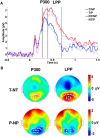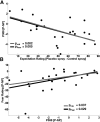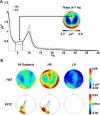Neural mechanisms of placebo anxiolysis
- PMID: 25972166
- PMCID: PMC6705432
- DOI: 10.1523/JNEUROSCI.4793-14.2015
Neural mechanisms of placebo anxiolysis
Abstract
The beneficial effects of placebo treatments on fear and anxiety (placebo anxiolysis) are well known from clinical practice, and there is strong evidence indicating a contribution of treatment expectations to the efficacy of anxiolytic drugs. Although clinically highly relevant, the neural mechanisms underlying placebo anxiolysis are poorly understood. In two studies in humans, we tested whether the administration of an inactive treatment along with verbal suggestions of anxiolysis can attenuate experimentally induced states of phasic fear and/or sustained anxiety. Phasic fear is the response to a well defined threat and includes attentional focusing on the source of threat and concomitant phasic increases of autonomic arousal, whereas in sustained states of anxiety potential and unclear danger requires vigilant scanning of the environment and elevated tonic arousal levels. Our placebo manipulation consistently reduced vigilance measured in terms of undifferentiated reactivity to salient cues (indexed by subjective ratings, skin conductance responses and EEG event-related potentials) and tonic arousal [indexed by cue-unrelated skin conductance levels and enhanced EEG alpha (8-12 Hz) activity], indicating a downregulation of sustained anxiety rather than phasic fear. We also observed a placebo-dependent sustained increase of frontal midline EEG theta (4-7 Hz) power and frontoposterior theta coupling, suggesting the recruitment of frontally based cognitive control functions. Our results thus support the crucial role of treatment expectations in placebo anxiolysis and provide insight into the underlying neural mechanisms.
Keywords: EEG; anxiety; event-related potentials; frontal midline theta; placebo effect.
Copyright © 2015 the authors 0270-6474/15/357365-09$15.00/0.
Figures







Similar articles
-
The Functional Role of Large-scale Brain Network Coordination in Placebo-induced Anxiolysis.Cereb Cortex. 2019 Jul 22;29(8):3201-3210. doi: 10.1093/cercor/bhy188. Cereb Cortex. 2019. PMID: 30124792
-
Initial and sustained brain responses to contextual conditioned anxiety in humans.Cortex. 2015 Feb;63:352-63. doi: 10.1016/j.cortex.2014.09.014. Epub 2014 Oct 2. Cortex. 2015. PMID: 25460498
-
Placebo analgesia induced by verbal suggestion in the context of experimentally induced fear and anxiety.PLoS One. 2019 Sep 24;14(9):e0222805. doi: 10.1371/journal.pone.0222805. eCollection 2019. PLoS One. 2019. PMID: 31550290 Free PMC article. Clinical Trial.
-
Startle reactivity and anxiety disorders: aversive conditioning, context, and neurobiology.Biol Psychiatry. 2002 Nov 15;52(10):958-75. doi: 10.1016/s0006-3223(02)01665-7. Biol Psychiatry. 2002. PMID: 12437937 Review.
-
The relation of emotions to placebo responses.Philos Trans R Soc Lond B Biol Sci. 2011 Jun 27;366(1572):1818-27. doi: 10.1098/rstb.2010.0407. Philos Trans R Soc Lond B Biol Sci. 2011. PMID: 21576139 Free PMC article. Review.
Cited by
-
Placebos without deception reduce self-report and neural measures of emotional distress.Nat Commun. 2020 Jul 29;11(1):3785. doi: 10.1038/s41467-020-17654-y. Nat Commun. 2020. PMID: 32728026 Free PMC article. Clinical Trial.
-
Harnessing the placebo effect to enhance emotion regulation effectiveness and choice.Sci Rep. 2023 Feb 9;13(1):2373. doi: 10.1038/s41598-023-29045-6. Sci Rep. 2023. PMID: 36759537 Free PMC article. Clinical Trial.
-
Placebo treatment entails resource-dependent downregulation of negative inputs.Sci Rep. 2025 Mar 17;15(1):9088. doi: 10.1038/s41598-025-93589-y. Sci Rep. 2025. PMID: 40097556 Free PMC article.
-
Excitability regulation in the dorsomedial prefrontal cortex during sustained instructed fear responses: a TMS-EEG study.Sci Rep. 2018 Sep 28;8(1):14506. doi: 10.1038/s41598-018-32781-9. Sci Rep. 2018. PMID: 30267020 Free PMC article.
-
Cortical Excitability Dynamics During Fear Processing.Front Neurosci. 2019 Jun 4;13:568. doi: 10.3389/fnins.2019.00568. eCollection 2019. Front Neurosci. 2019. PMID: 31275095 Free PMC article.
References
Publication types
MeSH terms
Substances
LinkOut - more resources
Full Text Sources
Medical
